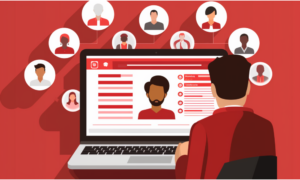Building HR’s digital environment one step at a time
- 6 Min Read
Through technology and the creation of the ‘digital workplace’, work is becoming something you ‘do’ rather than somewhere you ‘go’. Tim Waterton, VP of UK Business, M-Files, takes a deep dive into the digital environment of the future.
- Author: Tim Waterton
- Date published: Apr 5, 2019
- Categories

Until recently, the term workplace referred to a physical space where employees go to get work done. Now the term is more conceptual. Through technology and the creation of the ‘digital workplace’, work is becoming something you ‘do’ rather than somewhere you ‘go’. The digital workplace is an always-connected environment that provides instant access to everything an employee needs to complete their jobs regardless of their physical location.
The digital workplace empowers staff to capitalise on the latest digital tools, enabling them to maximise their abilities and productivity, and in turn, drive real benefits across a business.
If successful, a digital workplace can create competitive advantage, increase employee engagement and productivity, and also reduce operational costs. So where do many businesses sit in their journey to becoming fully digitalised? For some, it is simply about reducing the reliance on paper or better management of it. For others, it is streamlining and automating business processes or if they are further along their journey, it’s about leveraging technologies such as AI and machine learning. Each company will have its own priorities based on their requirements. For a lot of organisations, their staff are the primary drivers who are putting their stamp on the company’s digital footprint. These are the ‘digital natives’.
Digital natives have an inherent understanding of digital technologies, having had it integrated into their lives since early childhood. They are part of a tech-savvy generation at the forefront of technological progress and want to be connected whenever they wish, from anywhere, whether in their personal lives as a consumer, or in their professional lives as an employee. These digital natives are entering the workforce and transforming it at a rate which is placing enormous pressures on employers and business departments to keep pace. One particular example is HR.
The HR department is undergoing rapid and profound changes. Historically, it’s been seen as a support function focused on delivering employee services across a business. Today, HR is now being asked to take on a much bigger role in helping organisations build a comprehensive digital working environment. Not only will this support wider business units achieving their digital transformation aspirations, but it will also bring under the microscope HR’s own digital capabilities.
Increasingly, organisations are hiring young, digitally savvy workers who are comfortable doing things themselves and sharing information in a transparent way. As these digital-savvy employees move into a role, they expect their employer to provide the tools to help support this. If an employer fails to provide this, those digital natives will be on the lookout for an employer who can. Evidence to support this came from a research paper from Microsoft and Ingram Micro Cloud, revealing that a quarter of under 35’s worry about not having the required skillsets and qualifications needed to progress in their career. With this in mind, if the HR department is to be at the forefront of an organisation’s digital movement, it needs to have the infrastructure in place to support this. The use of artificial intelligence (AI), and its anticipated impact on the HR department, is perfect case-in-point.
An example of the way that AI can be utilised to streamline a standard HR process, would be the processing of CVs when advertising a vacancy. The demand for certain jobs can often see the HR department inundated with CVs meaning manually reviewing these documents is challenging. Automating the selection of resumes accelerates the recruitment process, while promising to improve its quality, thanks to machine learning functions. In this scenario, the machine ‘learns’ what the specific needs of a certain position are, and what qualities are required to support it. While undoubtedly, innovations such as this will improve efficiency within the HR function – again – it’s imperative that this is underpinned with the right infrastructure. Arguably, this is reinforced by how the HR department manages its information.
Traditionally, HR is an incredibly ‘document intensive’ process, both at the front and back-end of an employee’s tenure. This is especially true when you consider the impact of regulations such as the General Data Protection Regulation (GDPR).
The typical CV will contain ‘Personally Identifiable Information’ (PII) such as personal addresses, contact details and driving licences. This information needs to be controlled, protected and disposed of in compliance with the requirements of the regulation and this starts from the moment you first advertise a job.
Whether it is via a job board, an employment website, or directly via an email, you need to provide information on how the data will be processed, how long it will be retained for, and if the data they shared with you will be transferred overseas (if, for example, you have multiple offices). You will also be required to provide information around how an individual can determine if you hold data on them, how they can check what this, how they can rectify the data it if is incomplete or wrong, and how they can enact their ‘right to be forgotten’.
This all happens before HR even receives a CV. Moving onto the next stage of the recruitment process more personal data will be exchanged between employer and candidate. This again requires that information to be managed, stored and destroyed in accordance with GDPR and is often way before a successful candidate is even entered into your HR system.
Critically, this reinforces the volume of information that organisations are expected to hold on potential and existing employees and the challenges which arise from this. Technologies such as AI will bring excitement and innovation to a department but will be useless if-in-fact your biggest challenge remains the need to digitalise 20 years of employee records from paper. The old saying ‘learn to walk before you can run’ very much applies.
Ultimately, HR will play a critical role within the digital workplace, not just in terms of supporting strategy delivery but equally in how technology is deployed and used across the department. Getting those files and processes off paper and into digital form will enable you to automate your document management activities. Intelligent information management solutions, for example, can be leveraged to make the management of this information much more efficient. Metadata-driven information management solutions allow organisations to simplify how staff access, secure, process and collaborate on documents.
Doing this will enable you to build processes around your CVs, ensure that you’re GDPR compliant and finally, allow you to effectively manage employee on-boarding and off-boarding equally. Once done, you can then have the confidence to go out and explore introducing new technologies like AI, safe in the knowledge that the right digital infrastructure is in place to support your department and those across the wider organisation.









